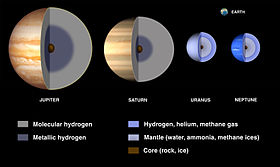
Back Planeetkern Afrikaans نواة كوكب Arabic Планетно ядро Bulgarian Derc'henn (planedenn) Breton Nucli planetari Catalan Planetární jádro Czech Планета тĕшĕ CV Πλανητικός πυρήνας Greek Planeda kerno Esperanto Núcleo (geología) Spanish


A planetary core consists of the innermost layers of a planet.[1] Cores may be entirely solid or entirely liquid, or a mixture of solid and liquid layers as is the case in the Earth.[2] In the Solar System, core sizes range from about 20% (the Moon) to 85% of a planet's radius (Mercury).
Gas giants also have cores, though the composition of these are still a matter of debate and range in possible composition from traditional stony/iron, to ice or to fluid metallic hydrogen.[3][4][5] Gas giant cores are proportionally much smaller than those of terrestrial planets, though they can be considerably larger than the Earth's nevertheless; Jupiter's is 10–30 times heavier than Earth,[5] and exoplanet HD149026 b may have a core 100 times the mass of the Earth.[6]
Planetary cores are challenging to study because they are impossible to reach by drill and there are almost no samples that are definitively from the core. Thus, they are studied via indirect techniques such as seismology, mineral physics, and planetary dynamics.
- ^ Solomon, S.C. (2007). "Hot News on Mercury's core". Science. 316 (5825): 702–3. doi:10.1126/science.1142328. PMID 17478710. S2CID 129291662.
- ^ Williams, Jean-Pierre; Nimmo, Francis (2004). "Thermal evolution of the Martian core: Implications for an early dynamo". Geology. 32 (2): 97–100. Bibcode:2004Geo....32...97W. doi:10.1130/g19975.1. S2CID 40968487.
- ^ Pollack, James B.; Grossman, Allen S.; Moore, Ronald; Graboske, Harold C. Jr. (1977). "A Calculation of Saturn's Gravitational Contraction History". Icarus. 30 (1). Academic Press, Inc: 111–128. Bibcode:1977Icar...30..111P. doi:10.1016/0019-1035(77)90126-9.
- ^ Fortney, Jonathan J.; Hubbard, William B. (2003). "Phase separation in giant planets: inhomogeneous evolution of Saturn". Icarus. 164 (1): 228–243. arXiv:astro-ph/0305031. Bibcode:2003Icar..164..228F. doi:10.1016/s0019-1035(03)00130-1. S2CID 54961173.
- ^ a b Stevenson, D. J. (1982). "Formation of the Giant Planets". Planet. Space Sci. 30 (8). Pergamon Press Ltd.: 755–764. Bibcode:1982P&SS...30..755S. doi:10.1016/0032-0633(82)90108-8.
- ^ Sato, Bun'ei; al., et (November 2005). "The N2K Consortium. II. A Transiting Hot Saturn around HD 149026 with a Large Dense Core". The Astrophysical Journal. 633 (1): 465–473. arXiv:astro-ph/0507009. Bibcode:2005ApJ...633..465S. doi:10.1086/449306. S2CID 119026159.
© MMXXIII Rich X Search. We shall prevail. All rights reserved. Rich X Search